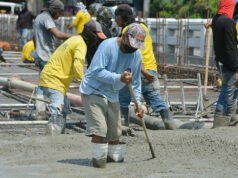Gov’t may have to extend strict lockdown
By Kyle Aristophere T. Atienza and Vann Marlo M. Villegas, Reporters
THE GOVERNMENT should extend a week-long strict lockdown that ends on April 4 to ease the load on hospitals in Manila, the capital and nearby cities and provinces amid a fresh surge in coronavirus infections, according to an expert.
“As long as there are patients who die because hospitals are full, we need to step back and provide options to reduce transmission and increase hospital capacity,” Teodoro J. Herbosa, a pandemic adviser to the government, told a televised news briefing in mixed English and Filipino on Wednesday.
He said extending the enhanced community quarantine would improve the situation in the capital region, where hospitals and their emergency rooms were full.
Mr. Herbosa, who also serves as the executive vice president of the University of the Philippines, said the lockdown — one of the strictest and longest in the world — should be coupled with public health measures such as testing, isolation and contact tracing.
Otherwise, lockdown efforts will have been wasted, he said, noting that a week was needed to lower the virus reproduction rate.
Health Undersecretary Leopoldo J. Vega on Wednesday expressed alarm over the “worrying” situation of hospitals in Metro Manila. Bed occupancy for coronavirus patients had reached a moderate risk level, he told an online news briefing.
Mr. Vega, who is the country’s treatment czar, said intensive care unit (ICU) beds for coronavirus patients in the cities of Quezon, Taguig, Makati and Navotas had reached a “highly critical level.”
The challenge for hospitals now is to convert ordinary wards into ICU rooms, where moderate and severe cases can be managed, he said. They should also accommodate as many coronavirus patients as they can, he added.
Mr. Vega said the government had hired 9,000 more health workers to boost the country’s pandemic response. About 3,000 were deployed to hospitals in Metro Manila, he added.
He also said the command center responsible for referring patients to hospitals had been receiving an average of 399 calls daily, or almost four times the number last year.
CASE TALLY
The Department of Health (DoH) reported 6,128 coronavirus infections on Wednesday, bringing the total to 747,288. It was lower than Monday’s record tally of 10,016 cases.
The death toll rose by 106 to 13,297, while recoveries increased by 491 to 603,746, it said in a bulletin.
There were 130,245 active cases, 95.8% of which were mild, 2.6% did not show symptoms, 0.6% were critical, 0.6% were severe and 0.38% were moderate.
The agency said 21 duplicates had been removed from the tally, while 47 recovered patients were reclassified as deaths. Six laboratories failed to submit data on March 30.
About 9.5 million Filipinos have been tested for the coronavirus as of March 29, according to DoH’s tracker website.
The coronavirus has sickened about 128.9 million and killed 2.8 million people worldwide, according to the Worldometers website, citing various sources including data from the World Health Organization. About 104 million people have recovered, it said.
Meanwhile, Senator Juan Edgardo M. Angara cited the need to boost hospital bed capacity after reports of coronavirus disease 2019 (COVID-19) patients being turned down.
“The current surge in cases of COVID-19 and its new variants has given us a rude awakening as to how much more we have to go to strengthen our health system,” he said in a statement.
“We must start to ramp up the capacities of our hospitals so that every Filipino who needs medical attention will get the care they deserve,” he added.
Also on Wednesday, Health Undersecretary Maria Rosario S. Vergeire said two quarantine facilities in Metro Manila had been reopened.
Rizal Memorial Coliseum, which has 97 beds, and the Ninoy Aquino Stadium, which has 127 beds, had been reopened earlier this month, she told an online news briefing.
The Quezon Institute, which has 112 beds, will be reopened on Monday. These facilities were closed after the infection rate eased in the past months.
Ms. Vergeire also said they were in talks with some hotels to turn them into quarantine facilities.
Bed occupancy was at 46.5% nationwide and 65.2% in Metro Manila as of March 29, according to DoH’s tracker website.



